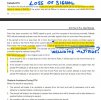What do you guys do when flying under tree cover and you are afraid of a loss of signal? I figure one thing to do would be to set it to land and not RTH. The other would be to maybe set the RTH altitude to be 4 feet or so and rely on the collision avoidance while it is coming back.
I am leary about setting it to land since there is a good chance it would land in the water. Here is a video example (Many places are 100 percent covered with tree branches.)
I am leary about setting it to land since there is a good chance it would land in the water. Here is a video example (Many places are 100 percent covered with tree branches.)












